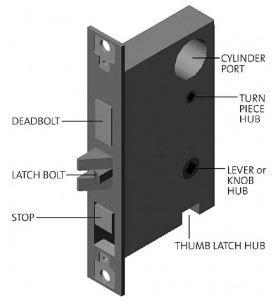I shouldn’t be that excited, but I am. I like a new year. I like the fresh start. It’s a clean slate, and what better way to start off a clean slate than by reviewing a little lock terminology?
Mortise and cylindrical locks are two of the most common locks used in the industry, but just like everything else, there’s a time and a place where they’ll work best. These two locks have pretty big differences, but are very easy to understand once you get the basics down.
Mortise Locks
Mortise locks are almost always used in commercial construction, especially on exterior doors and there are several parts included in a typical mortise lock installation.
- You have the actual lock body, which is the part that’s installed inside the mortise. The “mortise” is a pocket that’s cut out of the door itself and the lock body is fitted inside that pocket in the door.
- You also have the lock trim, which is similar to other lock trims (levers, handlesets, pulls, etc.)
- A mortise lock also has a strike plate, which is used to reinforce the pockets placed in the frame and the latch can extend inside to secure the door.
- Lastly, there’s a keyed cylinder which operates the locking function of the lock body.
Mortise locks are more complicated than cylindrical locks and often require a technician for installation and maintenance.
Cylindrical Locks
Cylindrical locks are also very common in commercial construction, but these guys are typically used on interior doors. They’re designed to be installed through the door. These are also used in residential buildings, but are typically a lower grade hardware.
They will have a leverset on either side of the door and this will retract the latch when turned or depressed.
Cylindrical locks are relatively easy to installed and can usually be done fairly quickly. Two holes are drilled through the face of the door for the lock chassis and, because these locks don’t have any sort of mortise or pocket to be drilled out, installation time is going to be much shorter.
They don’t require any sort of special tools or skill set to install or replace and most of the time, doors come pre-drilled and ready for the hardware to be installed.
See? I told you it was easy. Still have questions about which locks would work best for you? We happen to know a thing or two about them, so give us a ring!

